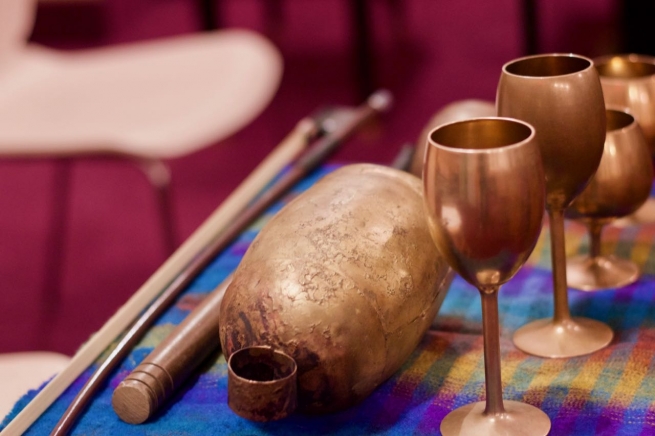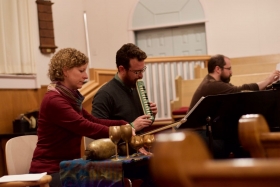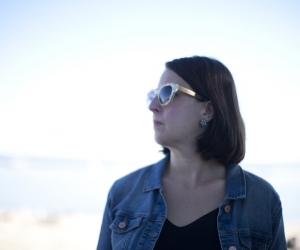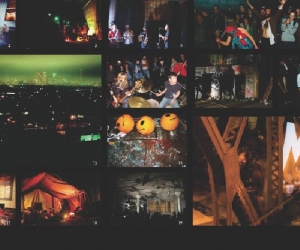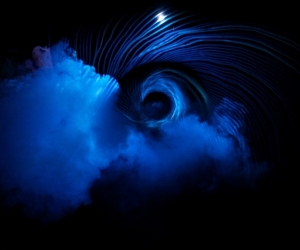THERE'S A DEEP HUSH in the church where I am sitting and nervously listening to an especially slow and fragile performance of my piece Ruins. It’s not that familiar, polite, sneeze-stifling, concert-quiet; it’s something else altogether: an acute gentleness that reveals the permeability of everything within and around its soft perimeter. Even the building itself seems to become more porous to the sound of traffic, birds, and the crisp autumn footfalls of passing pedestrians, as the music wafts faintly through the space.
The rest of the audience and the performers seem completely at ease; there’s no urgency pushing the music to do anything more than simply unfold.
A Place To Listen (APTL), Daniel and Laura Brandes’ monthly series held at James Bay United Church, carries a unique energy, even within the broader practice of presenting radically delicate music. Its peculiar, cozy vulnerability is one of a number of factors motivating younger artists to set anchor in Victoria.
Over the past years, Victoria’s awakening from a long slumber has been trumpeted by major travel media. Surrounded by copious natural environs, the city’s shimmering ocean vistas are punctuated by elegant, well-preserved historical buildings. Businesses close notoriously early, but the city’s reserved veneer is tempered by a laid-back islander outlook. Victoria has long boasted a rather healthy contemporary music scene for a mid-sized city. In addition to the University of Victoria’s forward-looking music program, there’s the Aventa Ensemble, Open Space Gallery, and the new-music-friendly local orchestra. Yet all these factors have not provided sufficient incentive for most recent grads to stay in town. Until recently.
“Historically, I think it would be accurate to say that composers and musicians would come here to study at UVic and then move on to somewhere else; but people have decided to start sticking around,” says Daniel Brandes. “All of a sudden, there’s kind of a lot happening.”
The Brandes’ decision to stay emerged organically. The couple committed to another year beyond Daniel Brandes’ completion of his Master of Music, in order to experience more of Victoria outside the confines of the campus. A Place To Listen was one of several outcomes of Daniel Brandes’ three-week mentorship in 2012 in Düsseldorf with composer, esteemed teacher, and Wandelweiser founder Antoine Beuger. Initiated in 1992, Wandelweiser is a network for and publisher of a number of like-minded, geographically scattered composers, including Jürg Frey, Eva-Maria Houben, Michael Pisaro, and more recently, Daniel Brandes. One could cite soft dynamics, gradual temporalities, and even prolificness as perceived shared traits; yet, as Brandes wryly states, “It’s not like any composer who’s named on the Web site is operating under some Wandelweiser-sanctioned mandate.”
In addition to concentrated one-on-one sessions with Beuger during the mentorship, Daniel Brandes attended a number of concerts in the series Beuger curates. Laura Brandes joined him for the final week of his term, and these concerts’ tenor of serene, communal reflection made a powerful impact on them both. Upon returning to Victoria they felt compelled to make a similar place in their community. This investment helped cement their decision to stay and eventually start a family.
“A Place To Listen was never just another concert series of new music,” Laura Brandes asserts. Emerging only after months of meticulous conversation around the kitchen table, it was designed to posit, as she says, “a counter to the hyper-stimulation of our culture.”
Laura Brandes is the odd one out in APTL, yet her involvement indicates some of its core values. Mostly a vocalist in the ensemble, she acquired her foundation from folk music and private experimentation, rather than from the formal training pursued by the other members. Her minor in musicology makes her especially attuned to social dynamics and discursive framing.
“It doesn’t have to do with traditional music per se,” says Laura of the series’ performance culture, “It has to do with human connection, vulnerability, brokenness, joy—things that I try to tap into when I’m performing.” This is reflected in the diverse and committed audience that has grown over APTL’s five seasons—many of whom have no musical background, and are drawn to its “culture of quiet attentiveness.”
Compared to its precise philosophical architecture, other elements of APTL remain decidedly homespun. Curation of the series, which is done on a month-to-month basis, draws from the Wandelweiser catalogue and from composers of adjacent affinities. This often translates to new work by emerging composers, including members of the in-house ensemble. Apart from Laura and saxophonist Erik Abbink, the band is populated by composers—Hollas Longton (violin), Nathan Friedman (clarinets), Maria Eduarda Mendes Martins (voice), Kristy Farkas (piano, voice), Alex Jang (mandolin), and Christopher Reiche (keyboard instruments), and of course Daniel Brandes (piano).
Their almost folksy modus operandi and lack of institutional funding haven’t hampered their ambition. They’ve hosted a number of illustrious guests—celebrated American pianist R. Andrew Lee, Los Angeles vocalist and composer Odeya Nini, and Colin Tilney, a lauded interpreter of early and contemporary music. Halifax’s Chik White (Darcy Spidle’s moniker when, among other things, he’s playing his perversely virtuosic solo jaw-harp) is on the bill for the 2017–18 season. In Spring 2017 they engaged in outreach with a residency on Saturna Island, where they offered workshops and a concert of new work specially composed for the event by Farkas, Jang, and Brandes.
“I’ve had this really visceral sensation of ‘we’ happening.” Brandes says of his experience performing at the series. The pursuit of this intangible collective feeling—perched on the threshold of perceptibility—has led him away from traditional composer–performer relations. While his scores had long afforded considerable freedom to their interpreters, his 2014 work a place for love (and grief) to dwell, conceived for Laura to intone diverse fragments of text with a “listening ensemble” supporting her, was his first piece to dispense with pitch material.
Subsequent pieces have seen an even greater reduction of his prescriptive involvement. each one: enfolded . . . loved . . . sacrifices almost any compositional specificity in favour of entrusting the ensemble with details. Carrying a dedication to a group of thirty-nine migrant workers discovered in a transport truck in San Antonio, Texas, this past July (eight of them died, another twenty were hospitalized), the piece offers only a few unassertive instructions to guide players through the contemplative, compassionate spaces found on the thirty-nine blank pages that follow.
Daniel Brandes’ work often employs theological texts and principles. “The Sabbath is a time to stop and return to oneself. Using this definition, you could describe [my work and the work programmed by APTL] as a sort of Sabbath music,” he says. Given that the series operates from a place of reflection in a church, it’s tempting to read all of it through a spiritual lens. Yet, neither founder is eager to impose these or other narratives onto their endeavours. Instead the music aspires to circumscribe fragile gathering places and communal listening rituals, where new modes of interaction can be discovered.
“These pieces that we make, these concerts that we put on—this is something that is very real that we are doing to make change in the world,” Brandes says. “Every piece, every concert really does present this opportunity, this potential to enter into something that is maybe otherwise to the world that we live in, in a very powerful and inspiring way.”
Alex Jang first encountered Wandelweiser music in 2012, while he was a master’s student at the University of Huddersfield (around the same time that, on the other side of the world, A Place To Listen had launched). Composer and professor Bryn Harrison had selected Beuger’s one tone, rather short, very quiet as the focus of that day’s graduate-composition seminar. It was, as Jang describes it, an “absolutely epiphanic moment.” While other pupils seized upon its apparent reductionism, the awestruck Jang’s response to the work was “What more do you really need than two people and a note?” Jang’s current music betrays a certain familial resemblance to Wandelweiser in its patient, murmured presentations, yet is distinguished by a more slippery, more meandering quality.
Weaned on a friend’s father’s extensive record collection and spurred by his own compulsive inquisitiveness, Jang was a precocious and slightly serious local when he enrolled at the University of Victoria in fall 2007. He studied under John Celona, a masterful orchestrator, according to Jang. During his graduate studies Jang returned to Victoria several times, and participated with great enthusiasm in the nascent A Place To Listen. The series and the music it champions became a primary factor in his decision to move back. In Victoria, he says, “this kind of music wasn’t just being discussed. It was actually being played.”
Jang has been a key member of the Victoria Composers’ Collective, which, after a quiet start in 2014, blossomed exuberantly over its 2015 season. Whereas A Place To Listen is sharply focused in its aesthetics and ritual, VCC is steadfastly eclectic. Consisting of a large, variable and diverse assembly of composer–performers—including much of the APTL ensemble, some current UVic students, and seasoned professionals like Sylvia Rickard—the collective is swiftly becoming an invaluable cultural resource, especially for younger artists. In its short existence, it’s mounted three editions of the Oak Bay New Music Festival and two of Woodstockhausen (chamber works for amplified ensemble, staged in a club scenario), while also having booked a tour throughout the interior of British Columbia.
Violinist, composer, and VCC member Hollas Longton, another Victoria native, has also been steeped in contemporary music since childhood. His father, composer Michael Longton, alongside celebrated Czech-Canadian composer and pedagogue Rudolf Komorous, played a vital role in establishing UVic’s uniquely exploratory academic culture. The younger Longton’s decision to himself become a composer and study at the university grew tangentially from his interest in abstract painting—“Almost against the urgings of my father,” he laughs. Following his graduation, he pursued a master’s at the Royal Conservatory of the Hague—a trajectory that’s become somewhat of a tradition (Allison Cameron, Martin Arnold, and Cassandra Miller all did the same). He’s now completing his Ph.D at University College Cork, while residing back home.
Since 2012, he’s been preoccupied with timbre and the concept of space: both in terms of considering the where of the music, and of cultivating a particular space to be inhabited by performers and listeners. His work contrasts standard narrative conceptions of structure and the exploration of concentrated sonic vocabularies, focusing on continuous forms instead—concerns which link him, Brandes, and Jang. Yet Longton’s compositional disposition is audibly more assertive and restless.
Former Ontarian Christopher Reiche, who settled in Victoria in 2006, has been an integral part of the APTL family from the beginning. A former student of UVic graduate Linda Catlin Smith at Wilfrid Laurier University, and of Christopher Butterfield at UVic, he has aligned a local lineage tracing back to Komorous. Like Longton, his curious experimentalism leads him across a wide assortment of sonic terrain. “I almost always start with a concept,” he says, yet he’s far from a staunch conceptualist. Instead, these ideas or questions ignite his creative process. Ultimately, he’d far sooner surrender to intuition than remain beholden to a preordained system. Two of his recent pieces illustrate his wide stylistic breadth and his willingness to confront new ideas at the expense of his own comfort.
Double Shadow, a commission from Contact Contemporary Music for a program with an LGBTQ+ theme, marked the first time Reiche thought of his music in terms of his queer identity. Reiche’s belief in music’s fundamental abstractness made this internal journey into the realm of the personal and political somewhat arduous. The finished piece offers nuanced metaphorical treatment of the idea of closetedness. A continuous cello and violin duet—intended as emblematic of queerness—is masked, to various extents, by other instrumental sonorities, symbolizing the spectrum of different circumstances in which one’s sexuality is obfuscated or thrust back into the closet.
This personal work is juxtaposed with Inconsistencies No. 2, a playful solo for ping-pong balls, which Reiche himself premiered at the most recent Oak Bay New Music Festival. It’s a convergence of two longstanding interests: performative Dadaist absurdity and a fascination with slim sonic possibilities.
From September 2011 until very recently, Reiche was the New Music Coordinator at Open Space Gallery, an artist-run institution that has presented exploratory art across disciplines since 1972. His programming encompassed a number of stalwart contemporary musicians, while also—like his music—never shying away from risk. He opened the 2016–17 season with the program “Why Can’t Minimal: Do This?”—with members of the VCC offering compositional reflections on minimalism as a complement to a parallel visual art exhibition that occupied the gallery space.
Kristy Farkas, who has called Victoria home for the past sixteen years, says the growing camaraderie is what’s kept her there. “When I graduated from UVic in 2004, the new-music community, especially composers, was really transient. Now there is a strong sense of community here among the composers.” As a member of the collective CURV, with fellow performer–composers Jennifer Butler and Marci Rabe, Farkas challenges what she calls “the solitary paradigm of classical composition.” CURV’s interwoven activities continued throughout Farkas’ sojourn in Japan from 2005 to 2008, during which time she discovered a latent but keen interest in improvisation.
Since returning, she’s gravitated toward collaborative ventures. Alongside Reiche, Farkas was a member of LaSaM, a group led by eclectic stalwart composer and sound artist Tina Pearson, which charts a gradient between structured improvisation and composition over its ambitious multimedia events. Farkas improvised collectively with unprocessed field recordings as part of Victoria Phonographers Union (an unofficial satellite of the Seattle Phonographers Union). During the first season of A Place To Listen, Farkas performed with the Phonographers. By the third season she had become a regular, as well as a close friend of Daniel and Laura Brandes. “It was the most intimate and moving performance,” she begins, describing the premiere of a dwelling place for you, a work of Daniel’s she premiered with Laura. “You can’t really call it a performance,” she continues. “It was more like an offering.”
Farkas gave her first and only solo piano recital at the series. “I think I express myself better as a performer than as a composer in a way,” she muses, “though I don’t even like performing, because I actually have really terrible performance anxiety. I feel compelled to do it because I’m very tactile. Even if I’m writing music, I have to have my hands at or on the instrument.”
Brazil-born composer Maria Eduarda Mendes Martins is similarly grounded in hands-on intuition. Her creative roots go back to her teen years, well before she had private music lessons or proper exposure to contemporary music. During her undergrad at Universidade Federal do Rio Grande do Sul in Porto Alegre, which she skewed strongly toward electronic music, she wrote Electroacoustic Mass, a large-scale work derived from recordings of various peers speaking and singing the traditional liturgical texts.
Shortly after graduating, she encountered the work of Dániel Péter Biró, now the head of UVic’s composition department, who had recently visited Brazil. In him, she found a receptive audience—the mix of heavy abstraction and spiritual themes resonated with Biró, who encouraged her to apply to UVic. Arriving in September 2013, her master’s provided her with her first private instruction in composition, under both Biró and Butterfield. The contemporary thrust of the performance program at UVic was almost equally invigorating, and the frequent collaborations with interpreters allowed her instrumental writing to flourish. After mining deep abstraction for a number of years, she has returned somewhat to the modal melodicism of her youth. Yet now she’s taken to rendering it three dimensionally, using all manner of microtonal and spectral shadings.
One of the younger members of Victoria’s vibrant composer community, Mendes Martins has already been tapped by some of the country’s key interpretive talent, including Duo Corvi and Brazilian-Canadian pianist Luciane Cardassi. She’s also taken a leadership role within the Victoria Composers Collective, and is beginning to present her own concerts as well. Even within her short time in Victoria, she’s witnessed considerable change, some of which might help reorient young artists elsewhere in the community. “Christopher Butterfield mentioned that students, after their degrees, tended to gravitate around the university,” she says. “Economically and in terms of real estate, Victoria is growing. I see new buildings going up all the time and new business coming. Maybe this would help. It has to start somewhere, this movement of creating a site for young musicians and composers to develop.”
But sustaining and growing Victoria’s composer community still requires a certain level of self-sufficiency. “Out of necessity, it’s sort of a DIY culture,” comments Farkas. Yet this recent proliferation of grassroots support merges with Victoria’s rich musical history. It’s producing a unique, multifaceted, and stabilizing artistic milieu—one that has begun to register more widely.
“The last four years has been the first time there’s been a community of composers who have stayed in Victoria, willing to take their chances and each develop life as an artist here,” offers Christopher Butterfield, composer, professor and, more recently, the director of UVic’s music program. “It’s hard to say what it’s the result of, but being in a supportive community of like-minded people is a great incentive to stay. That’s not to say people don’t go away—they do: to graduate school, etc. But instead of staying away, now they come back.”
“Eldritch Priest once called Victoria the velvet rut,” muses Hollas Longton. “but it’s not so much a rut anymore.”
